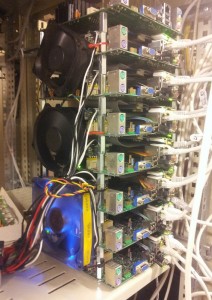Mini-ITX server hardware platform re-engineering
We’ve been re-engineering the Mini-ITX server platform for quite some time now. Some of you may remember the twitter pic of the old times:
https://twitter.com/seed_box/status/387552414615609344
All 3 of these stacks are still being used in our datacenter, and stacks by itself is not what we’ve been re-engineering. The method of stacking mini-itx server motherboards is actually quite a good, and low cost solution.
We have only made some simple, small changes to that. What is not seen in the above picture is that we mount a bunch of highly efficient strong fans directly to the stacks to cool all of the motherboards.
What we’ve been working on has been the disks, wiring and power distribution systems.
Updated power distribution for Mini-ITX servers
We have gone with super highly efficient 12VDC 860W and 1200W power supplies.
These only output 12VDC and do not require a preload on the 5V line for high power output like some power supplies do.
Best of all: These offer over 90% efficiency in a minimally sized package.
The high output means we can use a single supply to power up 64 (4 stacks) with single supply.
From the maintenance standpoint the most important achievement probably is the modularity of power output: We can easily hook up more outlets or remove existing ones from this supply.
Remote power control
We have been testing 2 discrete models of handling this.
The first one is a home automation focused solution, it is very barebones and comes with just a board + IP controller. These obviously need packaging.
Second model we’ve been testing is a Arduino based solution.
An power relay board and ethernet module wired to the Arduino board.
This is much more involved, and we wanted to include thermal + humidity, amperage, voltage etc. monitoring to this with logging capabilities, so the progress has been slow and we will first begin with the home automation targeted solution.
Local disks and custom wiring
We’ve been targeting to add local disk drives to all nodes and remove the SAN altogether, and this has been the most involved step of all. We utilize DC-DC power supplies (picoPSU) in our Mini-ITX servers and these do come with a set of output wiring, for the prototypes we’ve had to manually create this custom wiring and figure routing out etc.
We take the standard wiring, cut it from about 5-10cm from the input plug, replacing it with 3×1.5mm² power cabling of about 35cm. Take 2 or 4 sata power lead pigtails and connect them to those wires. Heat shrink sleeves + electrical tape on all solders.
Finally all is put together with SATA cables in a bunch with braided sleeve or cable ties. Later on we will contract someone to make these for us all ready in larger quantities, since this is taking a lot of time for each mini-itx server to complete.
To mount the mini-itx server hard drives physically we need to utilize 3×5.25″ to 4×3.5″ HDD Cages. We need 4 to 8 of these per stack.
We utilize cheap sheet metal ones, and weld them together into a tower, paint them and then swap out stronger, higher quality 120mm fans to each cage, and finally some vibration isolation in form of rubber feet under the towers and rubber isolators on against each hard drive.
Current stage of Mini-ITX Servers
We are now reaching final hardware prototyping stages for the mini-itx server platform and will soon do limited real-world testing with these. Based on the input we get at that stage we will finish the design and enter into larger scale production with these.
We have come a long way considering this was our very very first mini-itx server prototype to test if this actually works:
